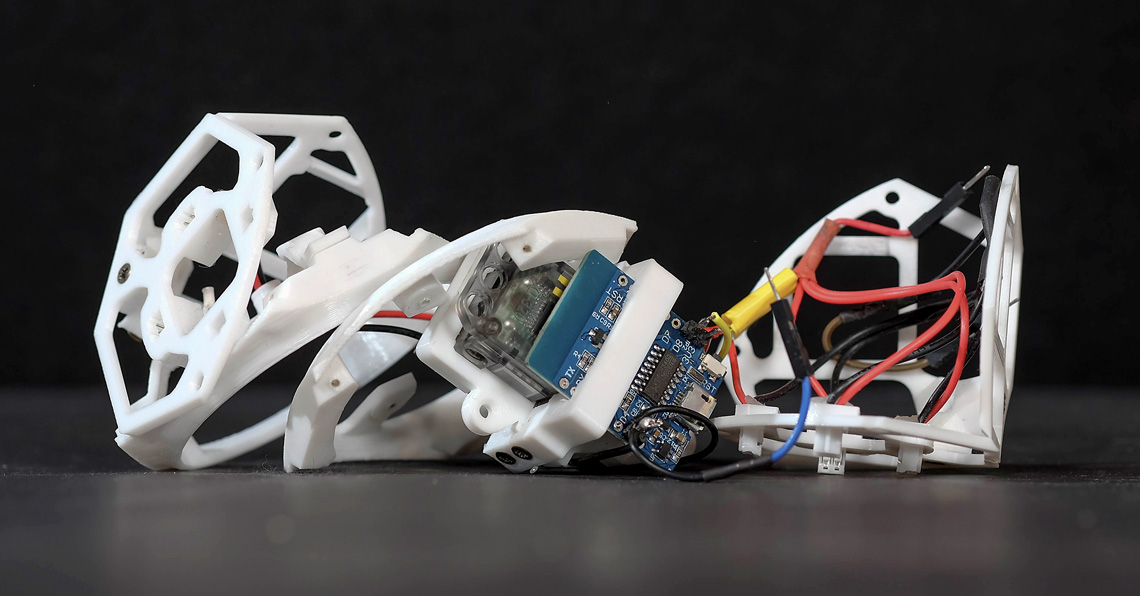How was it made? CuGo
Issue: XXVII.3 May - June 2020Page: 14
Digital Citation
Authors:
Kongpyung Moon, Peng Gao
Describe what you made.
We made an interactive board game where human players have to collaborate with robots in order to achieve certain goals, such as stacking passive blocks. We built modular reconfigurable robots (MRR), which human players can connect together in chains of up to four modules. When the passive blocks are placed on the board by human players, the robots detect their position. The robots then use their own kinematic intelligence to grab the passive blocks and stack them on top of one another. In this way, people without any professional knowledge in robotics can interact and collaborate with the robots to achieve a shared goal.
 |
Conceptual development and change of rotational axis. |
Briefly describe the process of how this was made.
Both the technical and conceptual developments were made through an iterative process of making digital and physical prototypes. As we faced failures, we were able to speculate on the problems and lead the project according to our concepts. We first started making it in a larger size and through iteration scaled it down to fit the board-game scale.
 |
First prototype, 330 grams and 12 cm edge length. |
What for you is the most important/interesting thing about what you made?
Scaling down the physical model was the greatest challenge of this project, in terms of the strength of the actuator and the weight of a module. A module not only must be lightweight but also should have a strong actuator to hold another module while rotating. The heavier the module, the stronger the actuator required. Therefore, finding a good balance between the weight of the module and the power of the actuator was vital. After a few prototypes, we realized that the batteries were the heaviest component, so we eliminated the batteries inside the module. Instead, it received its power from the board surface.
 |
Second prototype, 155 grams and 7 cm edge length. |
 |
Placing two 1000mAh LiPo batteries and the Dynamixel XL-320 servo on the second prototype. |
 |
Conductive surface on a board to power the prototype modules. |
 |
Customized DH parameters. |
 |
Third prototype, 60 grams and 6 cm edge length. |
Was this a collaborative process, and if so, who was involved?
Programming the kinematics behavior of the robot was a big challenge. We could not use the prewritten kinematic scripts for industrial robot arms because our module has a tilted rotational axis, while an industrial robot arm has a perpendicular rotational axis. Therefore, we had to write the scripts from scratch. Coming from an architecture background, we had no prior knowledge in calculating forward and inverse kinematics. So we reached out to master's students from the computer science department at UCL, who were kind enough to share their robotics lecture slides on forward kinematics with conventional DH parameters. Although the lecture notes did not cover arbitrary rotational axis calculation, we were able to learn the basics, apply them to our project, and then double check with the CS students whether our calculations were correct.
 |
Exploded model of the third prototype. |
How would you improve on this if you were to make it again?
If we had the chance to make this project again, we would customize the components inside, such as the ESP8266 mini PCB board and the Dynamixel XL-320 servo. If we were to develop a custom-shaped PCB board, the cable inside the robot would be less restrictive to the rotation. Also, many of the conventional servos are not designed to handle an angular load while rotating. If a custom actuator were developed for this specific angle, then I believe the number of modules in a chain could increase, opening up possibilities for other applications. Moreover, we would like to improve both the external and internal tracking systems. The position and load feedback from the actuator in a module would provide meaningful information about the configuration of the module chain.
 |
Exploded diagram of a single module. |
 |
Different joint connections between modules. |
 |
Tracking system to attain the position data of the blocks. |
Kongpyung Moon, Interactive Architecture Lab, University College London [email protected]
Peng Gao, Interactive Architecture Lab, University College London [email protected] with Jessica In (Principal Tutor) and Ruairi Glynn (Director)
http://www.interactivearchitecture.org/lab-projects/cugo
Copyright held by authors
The Digital Library is published by the Association for Computing Machinery. Copyright © 2020 ACM, Inc.


